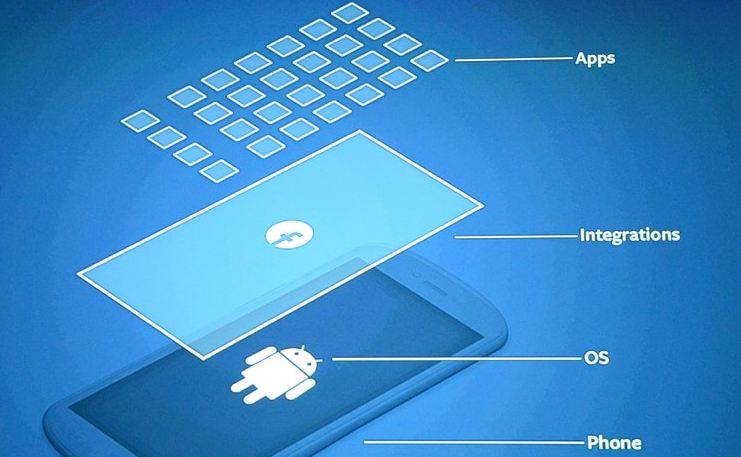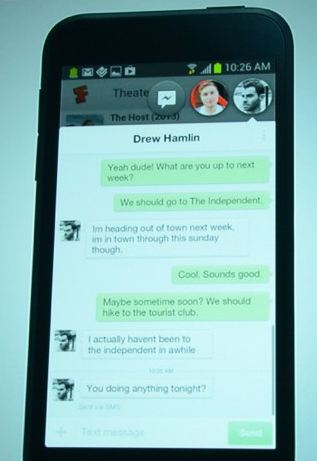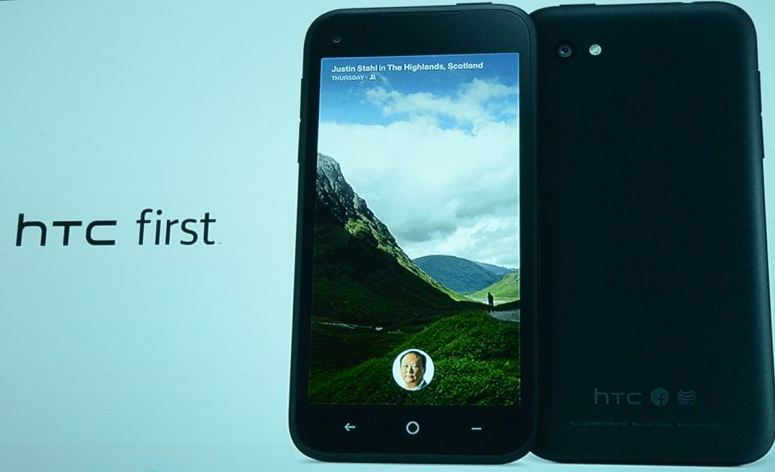Facebook has just announced Facebook Home and a “first smartphone” to deliver it as a reference design, the HTC First – offered in partnership with both HTC and AT&T. CEO Mark Zuckerberg was on hand to break the news today, but HTC CEO Peter Chou and AT&T mobile head honcho Ralph de la Vega also joined in the festivities to help Facebook launch the new platforms.
Let’s clear one thing up before we continue: there was absolutely no mention today of mobile advertising. Not a single clue was offered – nor any questions asked – as to how Facebook will deliver mobile ads or how intrusive those ads will ultimately become. We’re sure we’ll hear a lot more about this during Facebook’s next earnings call, but today it was of course in Facebook’s best interests not to go in that direction.
So then, just what do we now have on our hands? It is all definitely not a plane, and as far as smartphones go, the HTC First is most definitely no speeding bullet. But Facebook clearly hopes it has the cure for boredom on its hands.
Facebook Home is essentially a free application that will become available for download on April 12, 2013 on the Google Play store – you download it and install it and Facebook magically takes over key functionality on your standard Android phone.
Facebook CEO Mark Zuckerberg puts it this way: "We're not building a phone, and we're not building an OS. But we are building an experience that is deeper than any other app." But to what end exactly?
Let’s start with Home. As the image below shows, it is essentially a family of integrated applications, a Facebook home page (we can also probably get away with calling it an app launcher) dubbed Facebook Home, and what the Facebook team claims is standard Android. It is from its description what Facebook hopes is the one mobile home screen app to rule them all.
It puts Facebook and its content front and center for everything the user does and wants to do – if Facebook is the way they want to do it.

Regarding the home page, in a move that reminds us a good bit of the Windows Phone Tile UI, there is a new “Cover Feed,” which takes over and provides access to content and things you are interested in instantly. There is also a new messaging and communications capability dubbed Chat Head – which brings together Facebook’s chat capabilities as well as the smartphone’s base SMS messaging capabilities. One quick view of it is shown below.

This all integrates content, users and applications. So much for the demos Facebook itself demonstrated today. The idea here is to show off all the things that are good Facebook things any user will want to have on hand every living moment of every single day.
Facebook will deliver updates and new applications ongoing, with updates to Home likely to appear on a monthly basis for the foreseeable future. Perhaps as important, later in the year or early next year we will likely see Facebook Home also become available for Android tablets. Tablets were mentioned only in passing today, but there’s no reason whatsoever not to want them “Facebooked” as well.
Nor was there any mention of porting to other platforms, such as Windows Phone 8. And it goes without saying of course that Apple would never allow any such thing.
The HTC First
So then, on to the new HTC gadget. It is shown below.

Facebook, AT&T and HTC have been working on the Home project for some time. And it is now ready to become real – the new smartphone, which is an LTE device, will launch exclusively on AT&T on April 12, 2013 for $99.99. And it’s available for preorder today. Home will also be available on April 12 for the HTC One X, HTC One X+, Samsung GALAXY S III and Samsung GALAXY Note II.
The one significant and major difference is that the HTC First will have the entire platform fully pre-installed at the manufacturer level – when a subscriber buys the phone it will indeed be all Facebook all the time. A device manufacturer or OEM that opts to preinstall Home will also be able to deliver better integration with such things as system alerts and other phone features, such as unique camera integrations. There will also be additional optimizations possible at this level through hooks that will likely never be available through a direct end user install.
Partners who have already signed up include HTC, Samsung, EE, Qualcomm, Sony, Huawei, Alcatel One Touch, Lenovo, ZTE, and Orange. It isn’t clear to us if any optimizations from these partners will also involve some level of forking Android or if the OS remains the base OS.
A Solid Strategy?
Facebook Home is certainly all good for Facebook. There are, as far as we are able to determine, two strategies at play here.
First, there is the experiment to see just how many Facebook users across what hardware platforms will download and install Home. We may never know however the more important number – how many users download it, install it and then uninstall it? It also isn’t clear to us how easy an uninstallation of Home would be. And there is no way to predict how crisp performance of Home as an application download will be – though we now have more clues as to why Facebook opted out of HTML5 for new mobile development – at least for now.
The end result may not be a Facebook-branded phone, but the end result is a Facebook-centric device. Do users and manufactures and carriers really want such a thing? How likely is it that users who often say they prefer Android because of its inherent customizability will switch to a locked-in Facebook UI that isn’t really customizable?
In any case, this app download approach is the necessary strategy for higher end smartphone users.
Clearly the HTC First itself is designed to go after a lower end market. In the United States people with the necessary discretionary income to take advantage of both online and mobile ads are trending towards buying higher end Android devices – with the likes of the Galaxy III and Galaxy Note 2 making up a good chunk of the overall Android market these days. If it isn’t Samsung more than likely it will be LG, followed by HTC and then Google’s own Nexus devices.
In Europe there is less discretionary income to go around, but the trend isn’t much different.
Are people going to start tossing out their high end Samsungs for a lower end HTC device? No way! The truth of the matter is that these devices already have Facebook apps, and third party apps can easily get to Facebook if a user “really” wants to get to Facebook. Take a photo or video? Want to post a link and/or a comment? In fact, getting it to Facebook is easy no matter what you want to do. Many users may simply not want a Facebook Home.
We’re also curious as to why the smartphone vendors, which have been falling all over themselves to create strong product differentiation – look at Samsung’s efforts to get S Apps and its own ecosystem out there on the S4 – would want to go down a road in which everything becomes one homogenous big brother look and feel. That would be great for Facebook; it creates a Facebook phone even though the branding doesn’t say ‘Facebook.’
But what strong benefits will Facebook Home bring to the party for the partners exactly? We don’t know. In truth we don’t see any. We hardly see a significant lack of differentiation as a positive. Nor do we see “We do Facebook Better” as a winning marketing slogan for any of the announced partners to differentiate themselves.
The Low End
The second strategy – which is to specifically go after the low end markets and not worry about the high end – is far more interesting, and may suggest why the HTC First is indeed an excellent first smartphone to launch Facebook Home on.
Consider this: As we noted earlier in the U.S. and Europe, the trend is toward higher end phones. Meanwhile, Facebook earns ad revenue of approximately $4 per user on average in the U.S., and about $1.70 per user in Europe. That’s not anywhere near enough revenue to justify Facebook as an investment going forward. And whether or not Facebook will convert Facebook Home into a highly effective mobile ad delivery platform in the U.S. and Europe looks to us like a long shot.
But let’s now consider Asia, and in particular, India. In these markets, the low-end makes up a significant majority of device purchases, and if Facebook is going to launch an effective smartphone experience here it makes a great deal of sense to us that this smartphone must target en masse these two populations that trade in low end devices.
There’s more however – a low-end HTC or Samsung phone – or at least one that is priced to sell in India, would in fact also be considered a “high-end device” in India (and in Asia). An HTC First brings new cachet to these markets and begins to bring us much more in line with the “why” of what Facebook is attempting to do here. If Facebook can move the needle even a small amount in terms of ad revenue dollars it can generate in India, the company’s future begins to look a bit less uncertain.
More specifically, India has a huge – really huge – Facebook population. Compared to what Facebook earns on average in ad revenue per user in the U.S. and Europe, in India it currently amounts to all of about $0.50 or less per user. This is where Facebook has an opportunity to truly change several critical future revenue metrics by seeding the market with HTC First devices.
We like this move quite a bit, and in this case it is very clear what the benefits for HTC are here.
A Gathering of the Mobile Ad Platforms
Zuckerberg has made it exceedingly clear that mobility is now and will forever be the most critical key to both its near and future term growth and to its overall success over time. Today, Zuckerberg noted that, “We spend 20 percent of our phone time on Facebook, and with Instagram added to the mix it's 25 percent.”
So Zuckerberg confirms here that the mobile device is indeed a primary means to accessing Facebook.
What he means of course is that it is mobility that will drive its advertising opportunities and most of its revenue streams. What he also means is that effectively serving up well-targeted mobile ads is the critical imperative for Facebook’s entire existence and for ensuring it has a huge future – or any future.
In order to do so, Facebook needed to put in place a partner-driven ad marketplace, and it then began strengthening its capabilities by developing a fairly deep partnership with Datalogix – a startup that competes with Nielson. And finally, Facebook needed to develop its own “exclusive” search engine capability, which it did when it announced Graph Search on January 15, 2013.
Graph Search taps deeply into a Facebook user’s exclusive friend networks and seeks to deliver personalized and targeted details about such things as places to go, restaurants, etc. – you get the picture.
Finally, Facebook’s always available Timeline has been recently revamped to be specifically mobile and ad friendly.
So, Facebook now has the ad network in place – or falling into place – to provide an ad inventory, a Nielson capability to refine market advertising and ad targeting metrics, and an always accessed Timeline and always available Graph Search capability. And in the United States and Europe, it also has higher end users with discretionary income that use high end devices to deliver ads to. Now add possible new opportunities in India and eventually in Asia.
Though it wasn’t mentioned today, Facebook Home will allow Facebook to fully integrate all the pieces of a cohesive mobile ad delivery system – and this is the true next step to Facebook monetizing its billion users. It won’t get them all – but even a small percentage of them in the United States and Europe, coupled with a massive collection of active users in India and eventually Asia do indeed set the stage for strongly moving the revenue needle going forward.
Much if not all of this absolutely depends of course on Facebook Home and its new collection of integrated apps truly being the cure for boredom. If in fact it doesn’t cure boredom and, as many pundits are now beginning to suggest, the world is actually becoming bored with Facebook…well – Zuck will have some “splaining to do,” as Ricky would have said to Lucy.
Edited by
Braden Becker